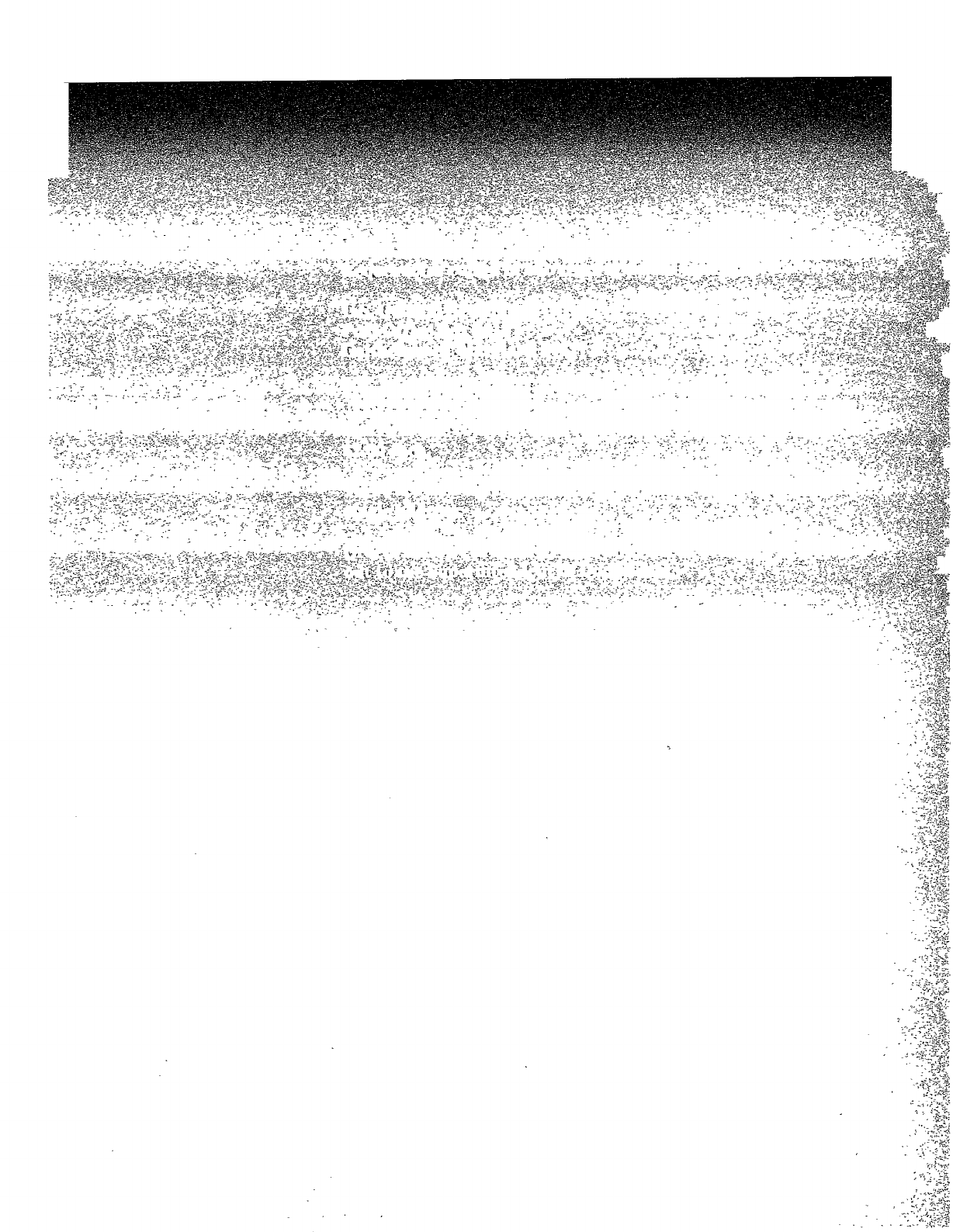
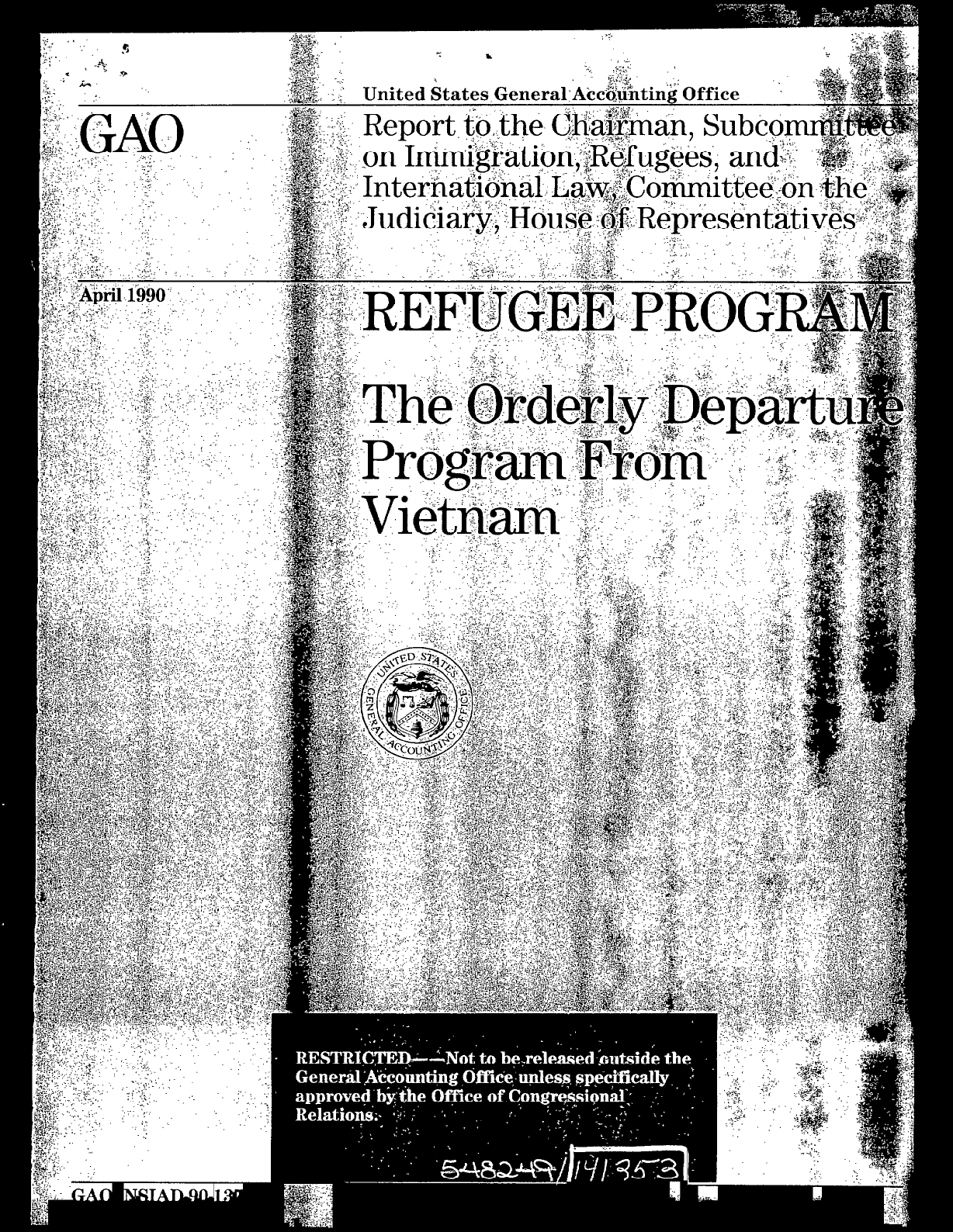

.
\
.
GAO
United States
General Accounting Office
Washington, D.C. 20548
National Security and
International Affairs Division
B-238006
April 11, 1990
The Honorable Bruce A. Morrison
Chairman, Subcommittee on Immigration,
Refugees, and International Law
Committee on the Judiciary
House of Representatives
Dear Mr. Chairman:
This report responds to your request that we evaluate the Immigration
and Naturalization Service’s
(INS)
practices and procedures for adjudi-
cating the cases of Vietnamese refugee applicants. You asked us to (1)
determine why approval rates for Vietnamese refugee applicants were
apparently low, (2) evaluate the quality and consistency of the INS adju-
dication process, and (3) determine if denied refugee applicants’ files
adequately reflected the bases for the examiners’ decisions. We also
determined whether Vietnamese of special interest to the United States
were being interviewed by INS examiners.
Results in Brief
We found that approval rates for Vietnamese refugee applicants
dropped from 100 percent during October 1988 through January 1989
to an average of about 36 percent during the next 6 months beginning in
February 1989. This drop in approval rates occurred because of an
August 1988 decision by the Attorney General that the INS should begin
applying its worldwide guidance for overseas refugee processing in
granting refugee status to Vietnamese applicants. The Attorney Gen-
eral’s decision meant that Vietnamese applicants would no longer be
given an automatic presumption of refugee status simply because they
were living in Vietnam, but would have to assert fear of persecution and
a credible basis for such a fear.
Although the Attorney General’s decision resulted in a drop in the
number of applicants granted refugee status, it did not result in fewer
Vietnamese being offered entry into the United States. Most of those
denied refugee status were offered entry into the United States as Public
Interest Parolees.
We found that the INS refugee adjudication process in Vietnam was gen-
erally thorough and consistent, and performed by experienced and well-
trained examiners. Our review indicated that reasons for denial of refu-
gee status were documented in the files for 87 percent of the cases we
Page 1
GAO/NSIAD90-137 Refugee Program

c
,
B-238006
reviewed and
INS
officials informed us that they have taken action to
assure that subsequent denial decisions are adequately documented.
At the time of our visit to Vietnam in July 1989, many Vietnamese of
special concern to the United States, such as individuals with a previ-
ously close association with the United States who had been detained in
Vietnamese re-education camps, were not being allowed by the
Vietnamese government to be interviewed by INS examiners. However,
an agreement was reached on July 30,1989, between the U.S. and
Vietnamese governments that, beginning in October 1989, INS examiners
could interview such individuals. Department of State and
INS
officials
reported that about 4,830 such individuals were interviewed from Octo-
ber 1989 through January 1990.
The Orderly Departure
The Orderly Departure Program
(ODP)
was established under a 1979
Program
Memorandum of Understanding between the United Nations High Com-
missioner for Refugees and the government of Vietnam to provide a safe
and legal means for people to leave Vietnam rather than clandestinely
by boat. The agreement provides for the departure of immigrants and
refugees for family reunion and humanitarian reasons. In addition to
serving as an orderly, predictable means for those wishing to depart the
country, it also serves to relieve the flow of refugees into first asylum
countries and to save the Vietnamese government the embarrassment of
the uncontrolled illegal exodus of thousands of its citizens.
The Memorandum of Understanding established a selection process for
those authorized to depart Vietnam based on exchanges of lists between
the Vietnamese government and the receiving countries, such as the
United States. Under the process, receiving countries submit to the
Vietnamese government a list of those for whom entry visas would be
granted. Vietnam, in turn, provides the country with a list of those eligi-
ble for exit visas. The United States processes for entry only those
whose names appear on both lists. Individuals whose names appear on
only one of the two lists could be subject to discussions between the
Vietnamese and U.S. governments.
Vietnamese can travel to the United States under the
ODP as
immigrants,
following normal U.S. visa issuance procedures, or as refugees. The
Departments of State and Justice developed three basic categories of
Vietnamese refugees eligible for entry under the
ODP.
Page 2
GAO/NSIAD!M-137 Refugee Program

B-238006
Category I: Family members of persons in the United States not cur-
rently eligible for immigrant visas.
Category II: Former employees of the U.S. government.
Category III:
Other persons closely associated or identified with the
United States’ presence in Vietnam before 1975,’ includ-
ing children of American citizens in Vietnam (Amera-
sians) and their immediate family members.
ODP Application
Procedures
The
ODP
Office at the U.S. Embassy in Bangkok, Thailand, administers
the program, augmented by staff of the International Catholic Migration
Commission. Vietnamese who rely on normal immigration channels must
have a relative in the United States obtain and file immigrant visa peti-
tions
(INS
Form I-130) with their local INS office. Approved petitions,
along with affidavits of relationships and other documents from spon-
soring relatives, are then sent to the
ODP
Office in Bangkok to serve as
immigrant visa case files. Refugee applicants still in Vietnam or their
relatives in the United States may directly petition the
ODP
Office in
Bangkok for refugee status. (Refugees already in the United States may
petition to have their spouses and children join them by filing a Visa 93
petition with their local INS office.)
After receiving the petitions, the
ODP
Office in Bangkok issues Letters of
Introduction to immigrant applicants in Vietnam. This occurs when their
visa eligibility dates become effective or are nearing the effective dates.
Refugee applicants whose case files indicate their eligibility for refugee
status, are also sent Letters of Introduction. A Letter of Introduction is a
document which states that the United States is willing to interview the
individual for possible acceptance and movement through
ODP,
but it is
not a guarantee of approval. Letter of Introduction holders normally
present the documents to the Vietnamese authorities as a preliminary
step in obtaining exit permissions and pre-departure interviews with INS
and State officials.
The
ODP
Office periodically receives from the Vietnamese government
names of people it will allow the
INS
and consular officials in Ho Chi
Minh City (previously Saigon) to interview. Upon receipt of these
names,
ODP
staff in Bangkok review the cases to determine which ones
‘The United States withdrew its remaining military forces and civilian presence from Vietnam after
the fall of the South Vietnamese government in April 1975.
Page 3
GAO,‘NSIALX90-137 Refugee Program
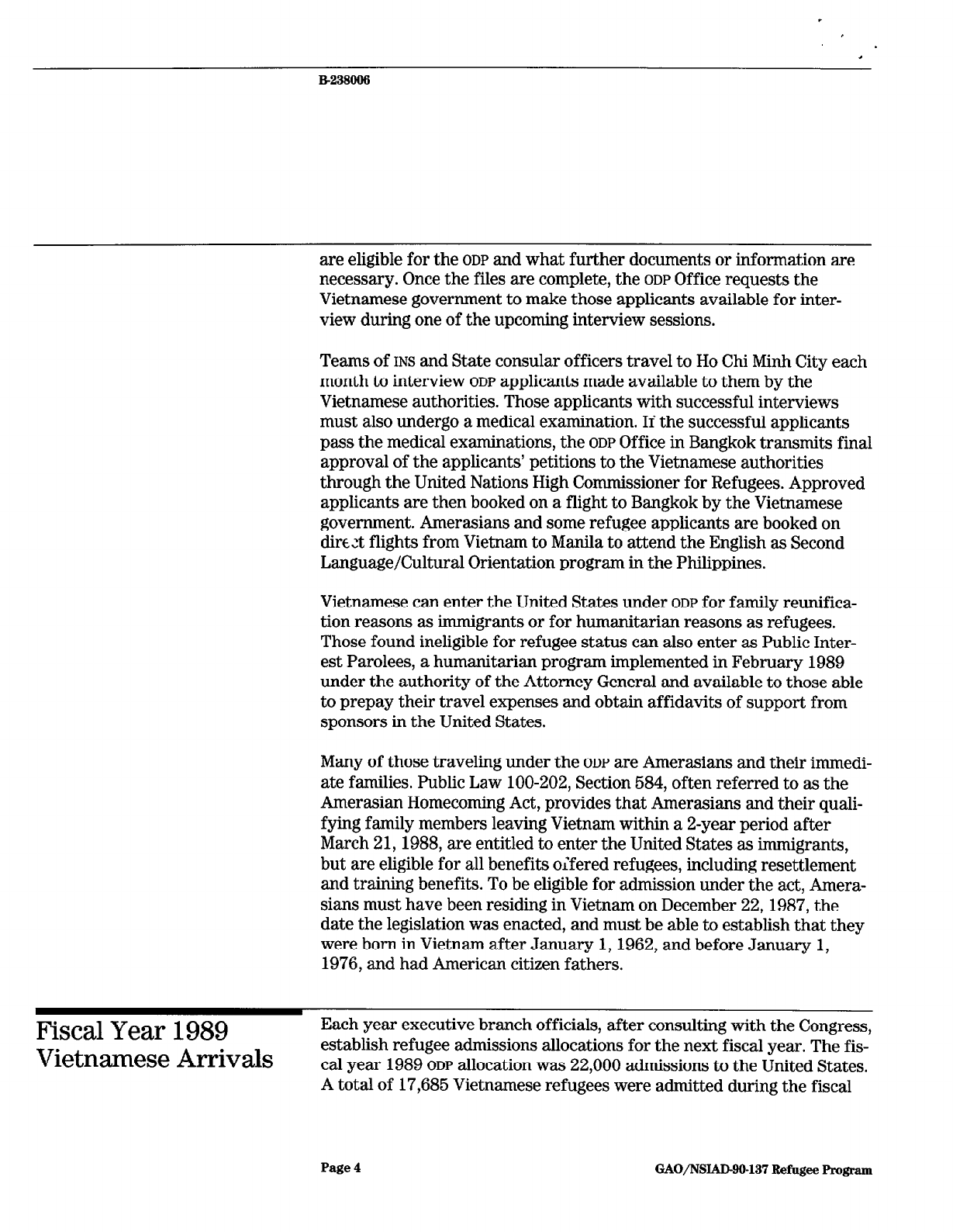
B-238006
are eligible for the
ODP
and what further documents or information are
necessary. Once the files are complete, the
ODP
Office requests the
Vietnamese government to make those applicants available for inter-
view during one of the upcoming interview sessions.
Teams of
INS
and State consular officers travel to Ho Chi Minh City each
month to interview
ODP
applicants made available to them by the
Vietnamese authorities. Those applicants with successful interviews
must also undergo a medical examination. II’ the successful applicants
pass the medical examinations, the
ODP
Office in Bangkok transmits final
approval of the applicants’ petitions to the Vietnamese authorities
through the United Nations High Commissioner for Refugees. Approved
applicants are then booked on a flight to Bangkok by the Vietnamese
government. Amerasians and some refugee applicants are booked on
dir& flights from Vietnam to Manila to attend the English as Second
Language/Cultural Orientation program in the Philippines.
Vietnamese can enter the United States under
ODP
for family reunifica-
tion reasons as immigrants or for humanitarian reasons as refugees.
Those found ineligible for refugee status can also enter as Public Inter-
est Parolees, a humanitarian program implemented in February 1989
under the authority of the Attorney General and available to those able
to prepay their travel expenses and obtain affidavits of support from
sponsors in the United States.
Many of those traveling under the
ODP
are Amerasians and their immedi-
ate families. Public Law 100-202, Section 584, often referred to as the
Amerasian Homecoming Act, provides that Amerasians and their quali-
fying family members leaving Vietnam within a 2-year period after
March 21,1988, are entitled to enter the United States as immigrants,
but are eligible for all benefits oifered refugees, including resettlement
and training benefits. To be eligible for admission under the act, Amera-
sians must have been residing in Vietnam on December 22,1987, the
date the legislation was enacted, and must be able to establish that they
were born in Vietnam after January 1,1962, and before January 1,
1976, and had American citizen fathers.
Fiscal Year 1989
Vietnamese Arrivals
Each year executive branch officials, after consulting with the Congress,
establish refugee admissions allocations for the next fiscal year. The fis-
cal year 1989
ODP
allocation was 22,000 admissions to the United States,
A total of 17,685 Vietnamese refugees were admitted during the fiscal
Page 4
GAO/‘NSIAD-W-137 Refugee F’rogram

,
B-238666
year, a shortfall of 4,315. The fiscal year 1990
ODP
refugee admissions
level has been set at 26,500.
State officials informed us that the fiscal year 1989 admissions shortfall
resulted from fewer former re-education camp detainees and U.S. gov-
ernment
employees being interviewed for refugee status than antici-
pated, and from the unforeseen award of Public Interest Parole to many
who, before February 1989, would have been awarded refugee status.
(Parolees do not count against refugee admission allocations.)
Until February 1989, INS officers conferred refugee status on virtually
all applicants in Vietnam based on the presumption that they
met
the
definition of a refugee as specified in the Immigration-Nationality Act of
1980. However, in February 1989,
INS
began to apply worldwide stan-
dards for refugee determination. This change resulted from an August
1988 decision by the Attorney General that INS should uniformly apply
the regulations of existing statutes regulating immigration processing.
The change meant that INS would no longer work from a presumption
that Vietnamese applying for
ODP
meet the definition of refugee. The
decision also provided that those not granted refugee status could be
considered for entry to the United States under the Attorney General’s
parole authority.
Refugee Denial Rates
The Attorney General’s decision to adjudicate refugee cases strictly in
Do Not Reflect a Drop
accordance with
INS
Worldwide Guidance for Overseas Refugees
P
recessing resulted in a sharp drop in the number of applicants granted
in ODP Activity
refugee status. However, most of those denied refugee status did not
originally apply to
ODP
as refugees. Most would have been immigrant
visa applicants but their visa petitions were not yet current, and were
considered for refugee status for family reunification reasons. Those
denied refugee status were offered Public Interest Parole.2 Thus, simply
because refugee denial rates were up does not mean
that
fewer
Vietnamese were leaving Vietnam under the
ODP.
While no refugee applicants were denied refugee status during INS’ first
three interview trips in fiscal year 1989, the denial rate averaged 63.6
percent during the next six trips. However, our analysis of agency data,
as reflected in Table 1.1, shows that during this latter period the
2Those offered parole are primarily the sons and daughters of immigrants and former w-education
camp detainees holding current visa petitions, according to State Department officials.
Page 6
GAO/‘NSIAD96-137 Eefngee Program
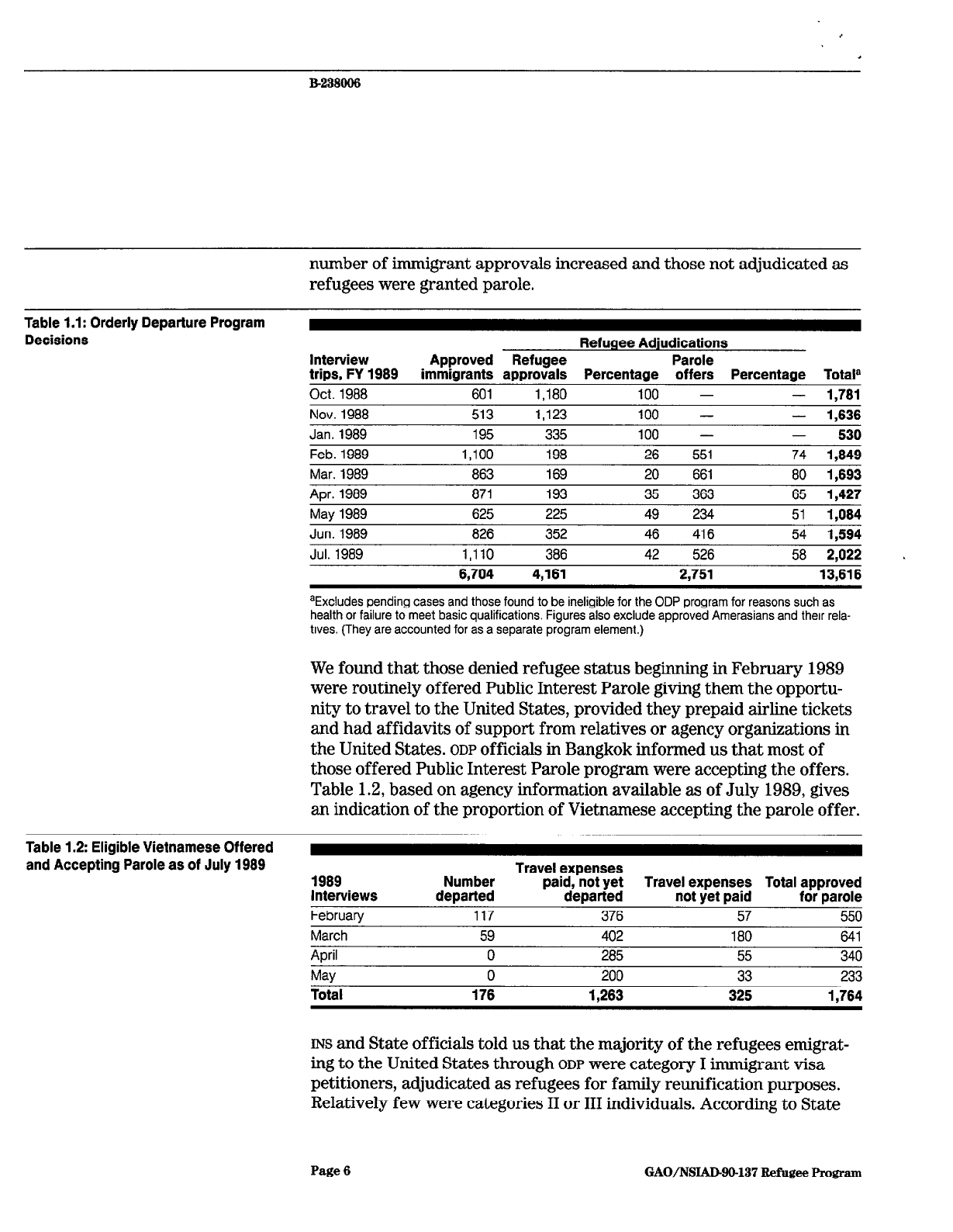
,
B-238666
number of immigrant approvals increased and those not adjudicated as
refugees were granted parole.
Table 1.1: Orderly Departure Program
Decisions
Refugee Adjudications
Interview
Approved Refugee Parole
trips, FY 1989
immigrants approvals Percentage offers Percentage TotaP
Oct. 1988 601
1,180
100 -
-
1,781
Nov.1988
513
1.123 100 -
-
1.838
Jan. 1989 195 335
100 - - 530
Feb.1989 1,100 198
26 551 74 1,849
Mar.1989 863 169
20 661 80
1.893
Apr.1989 871 193
35 363 65 1,427
May1989 625 225
49 234 51 1,084
Jun.1989 826 352
46 416 54
1,594
Jul. 1989 1,110 386
42 526 58 2,022 .
8,704 4,181
2,751 13,818
aExcludes pending cases and those found to be ineligible for the ODP program for reasons such as
health or failure to meet basic qualifications. Figures also exclude approved Amerasians and therr rela-
tives. (They are accounted for as a separate program element.)
We found that those denied refugee status beginning in February 1989
were routinely offered Public Interest Parole giving them the opportu-
nity to travel to the United States, provided they prepaid airline tickets
and had affidavits of support from relatives or agency organizations in
the United States.
ODP
officials in Bangkok informed us that most of
those offered Public Interest Parole program were accepting the offers.
Table 1.2, based on agency information available as of July 1989, gives
an indication of the proportion of Vietnamese accepting the parole offer.
Table 1.2: Eligible Vietnamese Offered
and Accepting Parole as of July 1989
1989
Interviews
February
March
April
Travel expenses
Number
paid, not yet
departed
departed
Travel expenses Total approved
not yet paid
for parole
117
376 57 550
59
402 180 641
0
285 55 340
May
0
200 33 233
Total 178
1.283
325
1.784
INS and State officials told us that the majority of the refugees emigrat-
ing to the United States through
ODP
were category I immigrant visa
petitioners, adjudicated as refugees for family reunification purposes.
Relatively few were categories II or III individuals. According to State
Page 6
GAO/NSL4IWO-137 Refugee Program
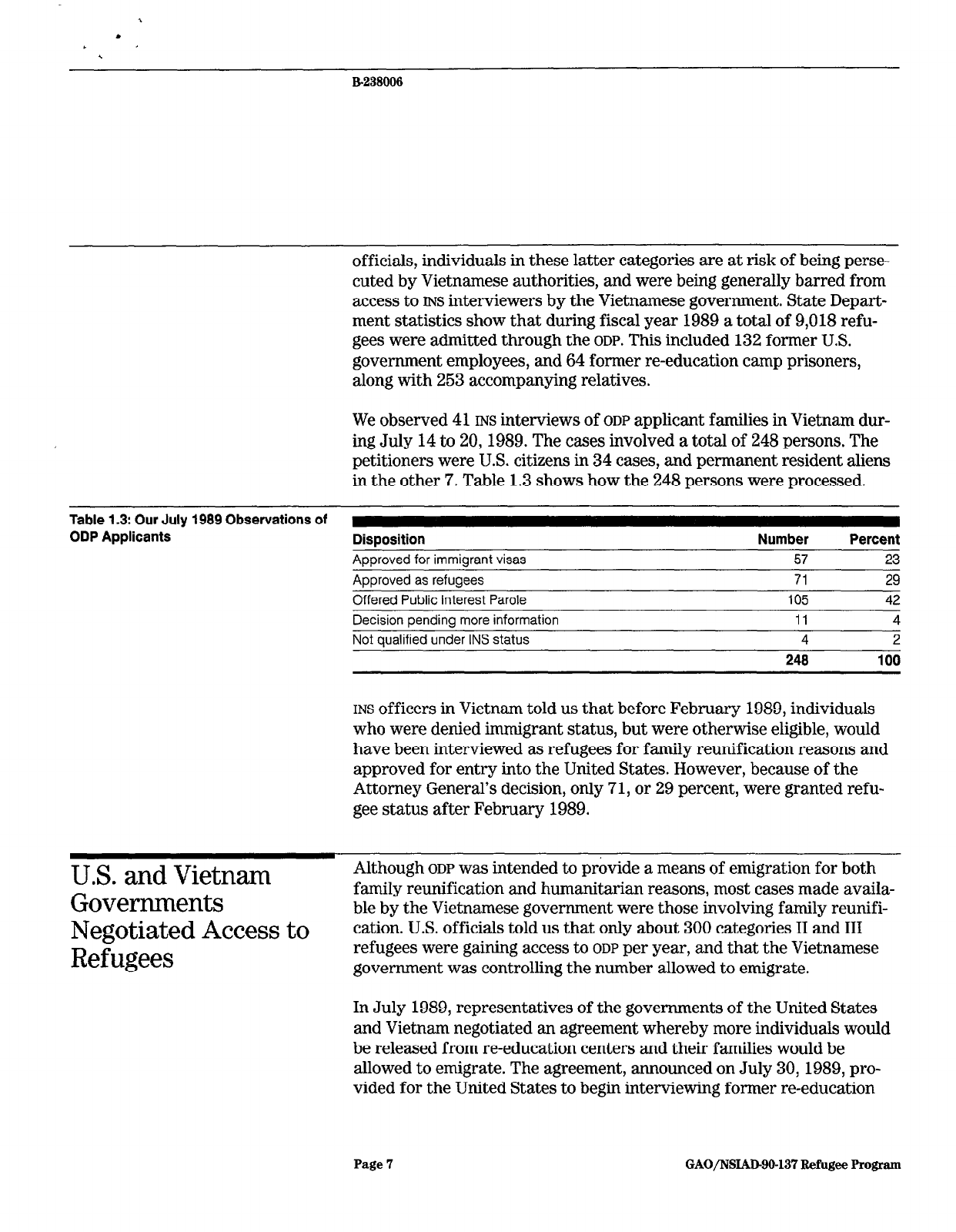
B-238006
officials, individuals in these latter categories are at risk of being perse-
cuted by Vietnamese authorities, and were being generally barred from
access to INS interviewers by the Vietnamese government. State Depart-
ment statistics show that during fiscal year 1989 a total of 9,018 refu-
gees were admitted through the
ODP.
This included 132 former U.S.
government employees, and 64 former re-education camp prisoners,
along with 253 accompanying relatives.
We observed 41 INS interviews of
ODP
applicant families in Vietnam dur-
ing July 14 to 20,1989. The cases involved a total of 248 persons. The
petitioners were U.S. citizens in 34 cases, and permanent resident aliens
in the other 7. Table 1.3 shows how the 248 persons were processed.
Table 1.3: Our July 1989 Observations of
ODP Applicants
Disposition Number
Percent
Approved for immigrant visas 57
23
Approved as refugees 71
29
Offered Public Interest Parole
105 42
Decision pending more information
11
4
Not qualified under INS status
4
2
248
100
INS
officers in Vietnam told us that before February 1989, individuals
who were denied immigrant status, but were otherwise eligible, would
have been interviewed as refugees for family reunification reasons and
approved for entry into the United States. However, because of the
Attorney General’s decision, only 71, or 29 percent, were granted refu-
gee status after February 1989.
U.S. and Vietnam
Although
ODP
was intended to provide a means of emigration for both
Governrrtents
family reunification and humanitarian reasons, most cases made availa-
ble by the Vietnamese government were those involving family reunifi-
Negotiated Access to
cation. U.S. officials told us that only about 300 categories II and III
Refugees
refugees were gaining access to
ODP
per year, and that the Vietnamese
government was controlling the number allowed to emigrate.
In July 1989, representatives of the governments of the United States
and Vietnam negotiated an agreement whereby more individuals would
be released from re-education centers and their families would be
allowed to emigrate. The agreement, announced on July 30,1989, pro-
vided for the United States to begin interviewing former re-education
Page 7 GAO/NSLAD-90-137 Refugee Program
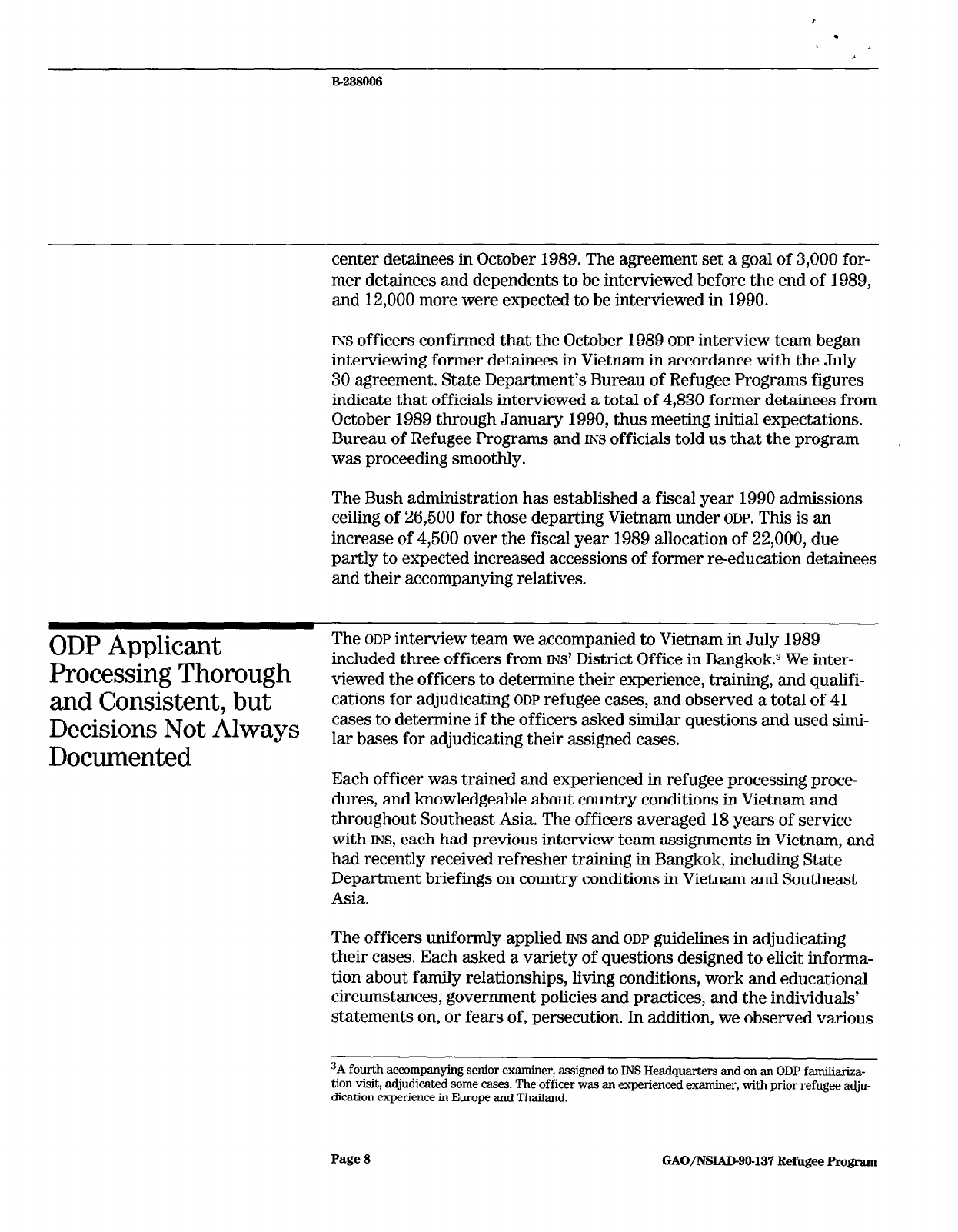
.
B-238006
center detainees in October 1989. The agreement set a goal of 3,000 for-
mer detainees and dependents to be interviewed before the end of 1989,
and 12,000 more were expected to be interviewed in 1990.
INS officers confirmed that the October 1989
ODP
interview team began
interviewing former detainees in Vietnam in accordance with
the
July
30 agreement. State Department’s Bureau of Refugee Programs figures
indicate that officials interviewed a total of 4,830 former detainees from
October 1989 through January 1990, thus
meeting
initial expectations.
Bureau of Refugee Programs and INS officials told
us that the
program
,
was proceeding smoothly.
The Bush administration has established a fiscal year 1990 admissions
ceiling of 26,500 for those departing Vietnam under
ODP.
This is an
increase of 4,500 over the fiscal year 1989 allocation of 22,000, due
partly to expected increased accessions of former re-education detainees
and their accompanying relatives.
ODP Applicant
The
ODP
interview team we accompanied to Vietnam in July 1989
Processing Thorough
included three officers from INS’ District Office in Bangkok.3 We inter-
viewed the officers to determine their experience, training, and qualifi-
and Consistent, but
cations for adjudicating
ODP
refugee cases, and observed a total of 41
Decisions Not Always
cases to determine if the officers asked similar questions and used simi-
Documented
lar bases for adjudicating their assigned cases.
Each officer was trained and experienced in refugee processing proce-
dures, and knowledgeable about country conditions in Vietnam and
throughout Southeast Asia. The officers averaged 18 years of service
with INS, each had previous interview team assignments in Vietnam, and
had recently received refresher training in Bangkok, including State
Department briefings on country conditions in Vietnam and Southeast
Asia.
The officers uniformly applied INS and
ODP
guidelines in adjudicating
their cases. Each asked a variety of questions designed to elicit informa-
tion about family relationships, living conditions, work and educational
circumstances, government policies and practices, and the individuals’
statements on, or fears of, persecution. In addition, we observed various
3A fourth accompanying senior examiner, assigned to INS Headquarters and on an ODP familiariza-
tion visit, adjudicated some cases. The officer was an experienced examiner, with prior refugee adju-
dication experience in Europe and Thailand.
Page8
GAO/NSIAD-90-137RefugeeProgram
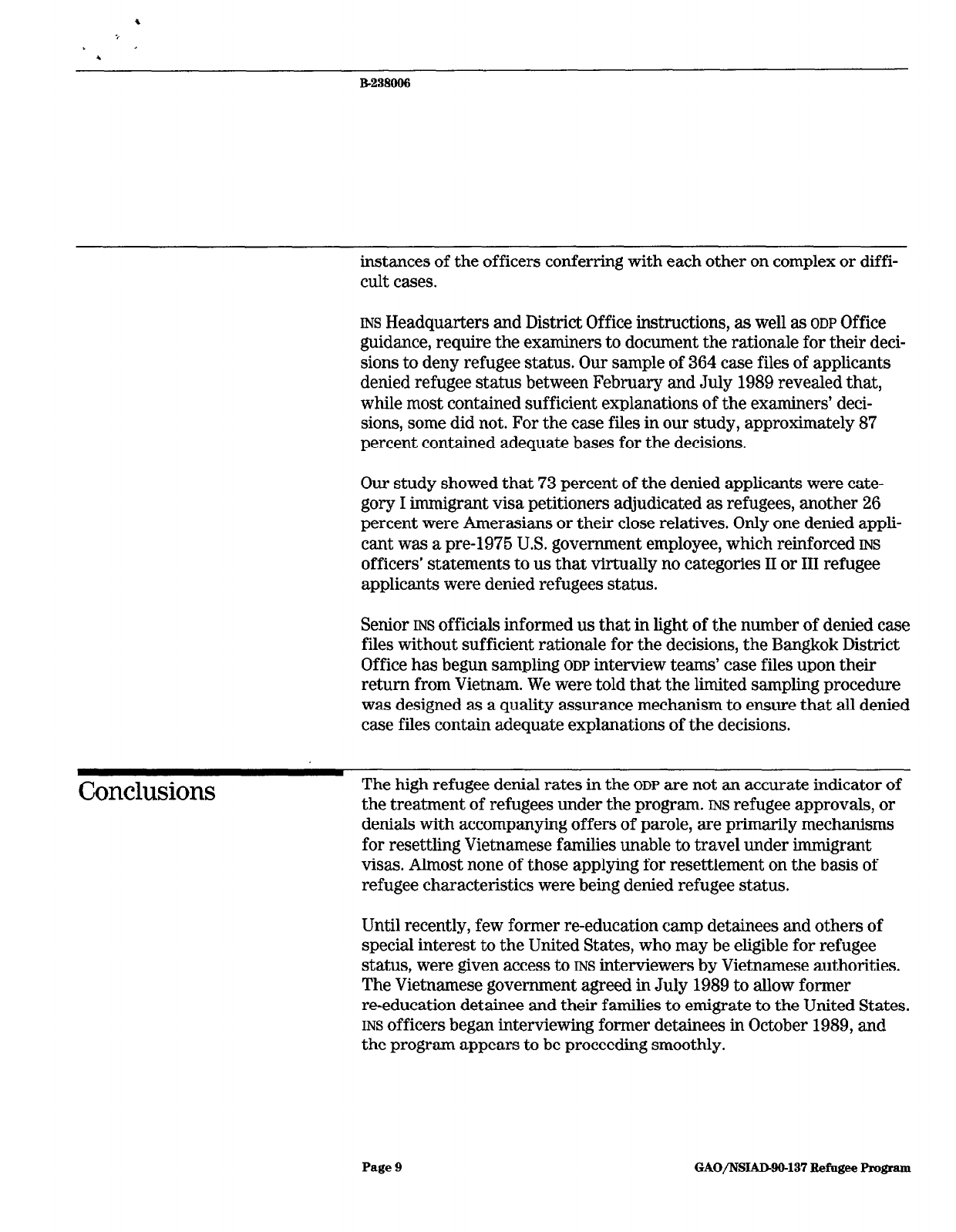
B238996
instances of the officers conferring with each other on complex or diffi-
cult cases.
INS Headquarters and District Office instructions, as well as
ODP
Office
guidance, require the examiners to document the rationale for their deci-
sions to deny refugee status. Our sample of 364 case files of applicants
denied refugee status between February and July 1989 revealed that,
while most contained sufficient explanations of the examiners’ deci-
sions, some did not. For the case files in our study, approximately 87
percent contained adequate bases for the decisions.
Our study showed that 73 percent of the denied applicants were cate-
gory I immigrant visa petitioners adjudicated as refugees, another 26
percent were Amerasians or their close relatives. Only one denied appli-
cant was a pre-1975 U.S. government employee, which reinforced INS
officers’ statements to us that virtually no categories II or III refugee
applicants were denied refugees status.
Senior
INS
officials informed us that in light of the number of denied case
files without sufficient rationale for the decisions, the Bangkok District
Office has begun sampling
ODP
interview teams’ case files upon their
return from Vietnam. We were told that the limited sampling procedure
was designed as a quality assurance mechanism to ensure that all denied
case files contain adequate explanations of the decisions.
Conclusions
The high refugee denial rates in the
ODP
are not an accurate indicator of
the treatment of refugees under the program. INS refugee approvals, or
denials with accompanying offers of parole, are primarily mechanisms
for resettling Vietnamese families unable to travel under immigrant
visas. Almost none of those applying for resettlement on the basis of
refugee characteristics were being denied refugee status.
Until recently, few former re-education camp detainees and others of
special interest to the United States, who may be eligible for refugee
status, were given access to INS interviewers by Vietnamese authorities.
The Vietnamese government agreed in July 1989 to allow former
re-education detainee and their families to emigrate to the United States.
INS
officers began interviewing former detainees in October 1989, and
the program appears to be proceeding smoothly.
Page 9
GAO,‘NSIAD9@137 Refugee Program

,
‘
EL238006
INS officials from the Bangkok District Office were experienced and well-
trained, and were processing
ODP
cases in Vietnam thoroughly and con-
sistently at the time of our visit. Refugee applicants’ case files contained
the bases for the examiners’ decisions in 87 percent of the eases we
reviewed, and the INS District office has implemented a file review pro-
cess, which should further ensure the documentation of denial decisions
by its examiners.
Scope and
Methodology
We analyzed available agency data on the
ODP
decisions made during
nine trips to Vietnam, covering October 24, 1988 to July 21,1989, to
determine whether approval rates for Vietnamese refugee applicants
had dropped during 1989, and if so, why the decline had occurred and
whether those denied refugee status were also being denied entry into
the United States.
To evaluate the quality and consistency of adjudication processes for
Vietnamese immigrants and refugees, we reviewed pertinent legislation
and regulations; interviewed officials and reviewed records at INS and
Department of State in Washington, D.C., the U.S. Embassy in Bangkok,
Thailand, and in Ho Chi Minh City, Vietnam. We analyzed 364 denied
refugee case files to determine whether the reasons for denials of refu-
gee status were well documented. In July 1989, we had firsthand obser-
vations of the program in Vietnam. We determined the nature and
extent of the background and experience of involved INS examiners. We
obtained information on access to Vietnamese of special interest to the
U.S. government through discussions with State Department, INS, and
embassy officials. Our review was performed between June 1989 and
December 1989, and was conducted in accordance with generally
accepted government auditing standards.
We did not obtain written comments on this report from agency offi-
cials. However, we obtained their oral comments and incorporated them
as appropriate in the text.
We are sending copies of this report to the Chairmen, House and Senate
Committees on the Judiciary; the Attorney General; the Commissioner of
INS; and the Director, Office of Management and Budget. We will also
make copies available to others upon request.
GAO
staff members Harvey J. Finberg, Computer Systems Analyst, and
Leroy W. Richardson and David R. Martin, Assistant Directors in the
Page10
GAO/'NSIAD-90-137RefkgeeProgram
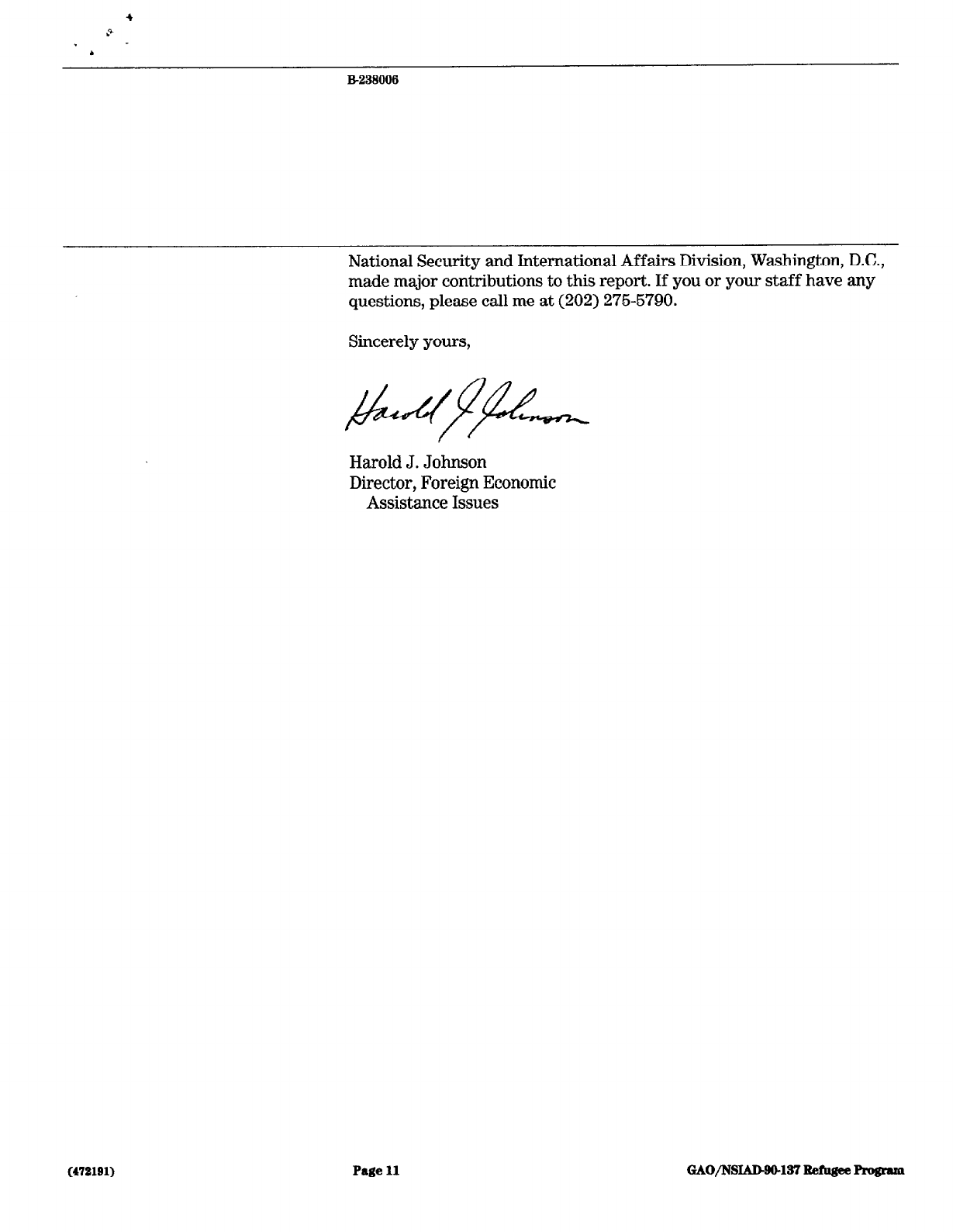
B-238006
(472191)
National Security and International Affairs Division, Washington, D.C.,
made major contributions to this report. If you or your staff have any
questions, please call me at (202) 275-5790.
Sincerely yours,
Harold J. Johnson
Director, Foreign Economic
Assistance Issues
Page 11
GAO/WXAD4W137 Refagee Program
